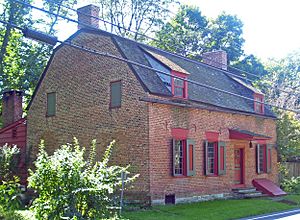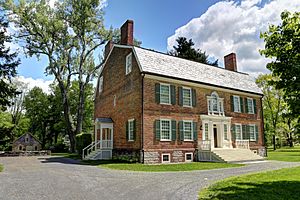Claverack, New York facts for kids
Quick facts for kids
Claverack, New York
|
|
|---|---|

Cornelius Muller House in Claverack
|
|

Location of Claverack, New York
|
|
| Country | United States |
| State | New York |
| County | Columbia |
| Government | |
| • Type | Town Council |
| Area | |
| • Total | 47.95 sq mi (124.19 km2) |
| • Land | 47.56 sq mi (123.18 km2) |
| • Water | 0.39 sq mi (1.01 km2) |
| Elevation | 522 ft (159 m) |
| Population
(2020)
|
|
| • Total | 6,058 |
| • Density | 126.340/sq mi (48.780/km2) |
| Time zone | UTC-5 (Eastern (EST)) |
| • Summer (DST) | UTC-4 (EDT) |
| ZIP code |
12513
|
| Area code(s) | 518 |
| FIPS code | 36-021-16045 |
| GNIS feature ID | 0978834 |
Claverack is a small town in Columbia County, New York, United States. About 6,058 people lived here in 2020. The town's name comes from the Dutch words Klaverakker. This means "Clover Fields" or "Clover Reach." Long ago, in 1705, a Dutch farmer found a mastodon tooth here.
Claverack is located in the middle of Columbia County. It is just east of the city of Hudson.
Contents
Exploring Claverack's Past
Claverack was once a very large area, about 60,000 acres. It was known as the Lower Manor of Rensselaer. This was part of a huge estate owned by an important Dutch family in the 1600s.
How Claverack Became a Town
During the American Revolution, Claverack officially became a town in 1778. Before that, it was called the District of Claverack. Over time, parts of Claverack were used to create other towns. In 1782, some land went to Hillsdale. Then, in 1785, the city of Hudson was formed from Claverack's land.
Schools and Historic Buildings
In 1779, a school called Washington Seminary was started here. It was founded by the local Dutch Reformed pastor. A famous student who attended this school was U.S. President Martin Van Buren. Later, the school changed its name to Claverack College. It closed its doors in 1902.
Many old homes from the 1700s are still in the area. One example is the William Henry Ludlow House, built in 1786.
Historic Places to See
Many buildings and places in Claverack are listed on the National Register of Historic Places. This means they are important to history. Some of these include:
- William Henry Ludlow House
- Claverack Free Library
- Double-Span Whipple Bowstring Truss Bridge
- George Felpel House
- First Columbia County Courthouse
- Stephen Hogeboom House
- Dr. Abram Jordan House
- Ludlow-Van Rensselaer House
- Jacob P. Mesick House
- Harmon Miller House
- Stephen Miller House
- Cornelius S. Muller House
- Harriet Phillips Bungalow
- Rev. Dr. Elbert S. Porter House
- Reformed Dutch Church of Claverack
- Stephen Storm House
- Trinity Episcopal Church
- Jan Van Hoesen House
- William W. Van Ness House
- Van Rensselaer Lower Manor House
- Conyn Van Rensselaer House
- Jacob Rutsen Van Rensselaer House and Mill Complex
Famous People from Claverack
Many interesting people have connections to Claverack:
- Stanley Bate: An English composer and pianist.
- Daniela Bertol: An architect, designer, and artist from Italy.
- Aaron Burr and Alexander Hamilton: These important historical figures worked on legal cases in the local courthouse.
- Mihail Chemiakin: A Russian artist.
- Nancy Fuller: A chef and TV host of Farmhouse Rules on the Food Network. She grew up here.
- Anne Grant: A Scottish poet and writer.
- Elizabeth Mumbet Freeman: An important figure in the fight for freedom, she was born here.
- Ismail Merchant and James Ivory: These filmmakers owned property in Claverack. They supported local causes, like the hospital in nearby Hudson. James Ivory still visits.
- Margaret Sanger: She attended the former Claverack College for two years.
- Joan Steiner: An American illustrator and puzzle designer.
- John J. Tallmadge: He was born in Claverack.
- Henry D. Todd Jr.: A U.S. Army major general, also born here.
- Martin Van Buren: He became a lawyer here.
Claverack's Geography
Claverack covers a total area of about 124.2 square kilometers (47.95 square miles). Most of this is land, with a small part being water.
Rivers and Creeks
The Claverack Creek flows into the town near the small community of Mellenville. It then runs southwest before turning north. This creek forms the western border of the town. The Taghkanic Creek is another important stream. It flows from the south and also forms part of the town's western border before joining Claverack Creek.
Major Roads
The Taconic State Parkway is a main road that goes north and south through the eastern side of Claverack.
Claverack's Population Over Time
| Historical population | |||
|---|---|---|---|
| Census | Pop. | %± | |
| 1820 | 2,813 | — | |
| 1830 | 3,038 | 8.0% | |
| 1840 | 3,056 | 0.6% | |
| 1850 | 3,208 | 5.0% | |
| 1860 | 3,477 | 8.4% | |
| 1870 | 3,671 | 5.6% | |
| 1880 | 4,347 | 18.4% | |
| 1890 | 4,518 | 3.9% | |
| 1900 | 4,416 | −2.3% | |
| 1910 | 4,114 | −6.8% | |
| 1920 | 3,747 | −8.9% | |
| 1930 | 4,168 | 11.2% | |
| 1940 | 4,071 | −2.3% | |
| 1950 | 4,406 | 8.2% | |
| 1960 | 4,989 | 13.2% | |
| 1970 | 5,711 | 14.5% | |
| 1980 | 6,061 | 6.1% | |
| 1990 | 6,414 | 5.8% | |
| 2000 | 6,395 | −0.3% | |
| 2010 | 6,021 | −5.8% | |
| 2020 | 6,058 | 0.6% | |
| U.S. Decennial Census | |||
In 2000, there were about 6,401 people living in Claverack. The population density was about 134 people per square mile. The average household had about 2.44 people.
The population includes people of all ages. In 2000, about 24.4% of the people were under 18 years old. About 19.1% were 65 years or older. The average age in the town was 41 years.
Communities and Places in Claverack
Claverack has several smaller communities and locations within its borders:
- Brick Tavern – A small community in the northwest part of town.
- Churchtown – A community located on the southern border of the town.
- Claverack – This is the main community, located in the western part of the town.
- Hollowville – A community southeast of Claverack village.
- Martindale – A community near the eastern town border, close to the Taconic State Parkway.
- Mellenville – A community in the northeast part of the town. The Mellenville Railroad Station is a historic building here.
- Philmont – This is a village located in the northeastern section of the town.
- Red Mills – A place just east of Claverack village.
- Upper Hollowville – A community between Hollowville and Martindale.
See also
 In Spanish: Claverack (Nueva York) para niños
In Spanish: Claverack (Nueva York) para niños



